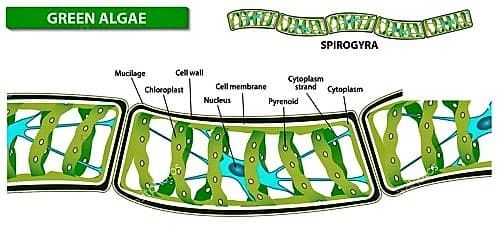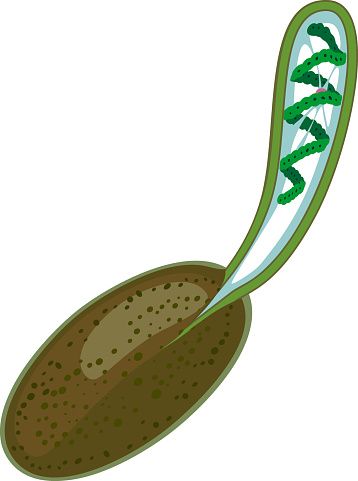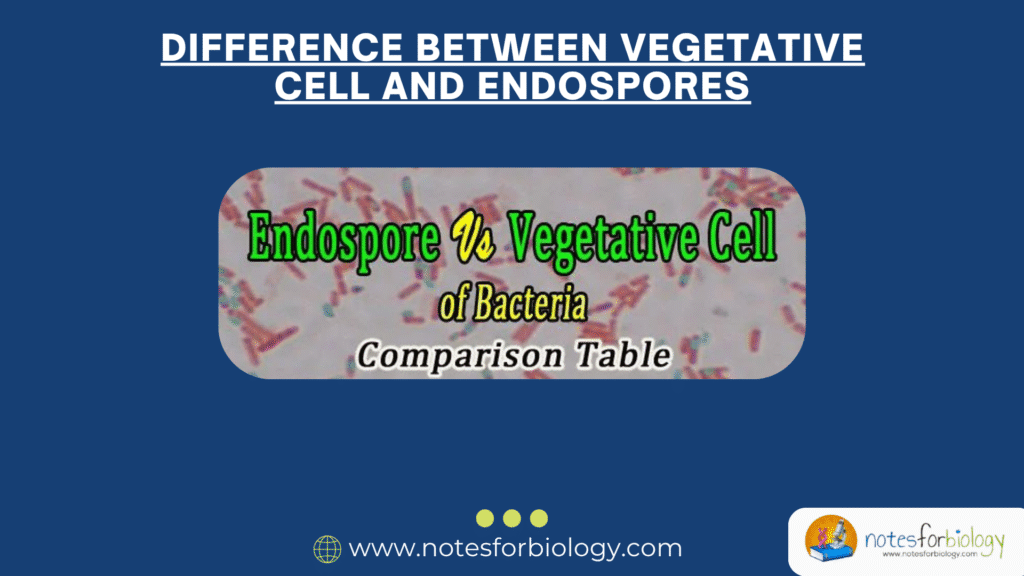Introduction
Spirogyra is a beautiful green alga, often found as slimy, thread-like masses floating in freshwater ponds, lakes, and slow-moving streams. It is named after its unique spiral-shaped chloroplasts, which can be easily seen under a microscope. It belongs to the division Chlorophyta, class Chlorophyceae, and order Zygnematales. It is widely used as a model organism in botany because of its simple structure, attractive appearance, and interesting method of reproduction.

Table of Contents
Habitat of Spirogyra
Spirogyra lives mostly in freshwater habitats like ponds, ditches, lakes, and quiet streams. It prefers still or gently flowing clean water that is rich in sunlight. You can often spot it as green, slippery, slimy masses floating on the water’s surface, especially during spring and summer.
It grows best in areas with:
- Moderate sunlight
- Neutral to slightly alkaline pH
- Low pollution levels
- Rich supply of minerals like nitrogen and phosphorus
It plays an important role in aquatic ecosystems. It provides oxygen through photosynthesis and serves as food for small aquatic animals.
Structure of Spirogyra

1. General Appearance:
Spirogyra appears as long, green, silky threads made up of cylindrical cells joined end to end. These threads are unbranched, soft, and slippery due to the presence of a slimy mucilage covering.
2. Cell Wall:
Each cell has a double-layered wall:
- The outer layer is made of pectin and gives the slimy texture.
- The inner layer is made of cellulose, which gives strength.
3. Cytoplasm and Organelles:
- The cytoplasm lines the inside of the cell wall.
- Inside the cytoplasm, there is a large central vacuole filled with cell sap.
- The nucleus is suspended in the cytoplasm by thin strands.
- The most striking feature is the presence of one or more spiral (helical) chloroplasts per cell. These chloroplasts contain pyrenoids, which store starch.
4. Filaments:
Spirogyra filaments are haploid (n) and non-motile. They grow by cell division and can become visible to the naked eye as floating green masses.
Reproduction in Spirogyra
Spirogyra reproduces both asexually and sexually.

Asexual Reproduction
Asexual reproduction is not very common in Spirogyra but occurs under favorable conditions through fragmentation.
- The filament breaks into two or more parts.
- Each part grows into a new filament.
- Fragmentation happens naturally due to mechanical injury or decay of older cells.
This method helps Spirogyra to multiply quickly when water and sunlight are abundant.
Sexual Reproduction
Sexual reproduction in Spirogyra occurs by a process called conjugation. It is an advanced form of reproduction in algae and results in the formation of a zygospore.
There are two types of conjugation in Spirogyra:
1. Scalariform Conjugation (ladder-like):
- Two filaments come side by side.
- Tubes called conjugation tubes form between opposite cells of the two filaments.
- The protoplast of one cell moves through the tube into the opposite cell.
- The two protoplasts fuse to form a diploid zygospore.
2. Lateral Conjugation (within the same filament):
- Occurs in some species.
- Two adjacent cells of the same filament form conjugation tubes.
- The contents of one cell move into the other and fuse to form a zygospore.
Important features of sexual reproduction:
- It is isogamous (both gametes are similar in shape and size).
- The resulting zygospore is diploid (2n) and has a thick, resistant wall.
- The zygospore helps the organism survive harsh conditions like drying or freezing.
Germination of Zygospore

The zygospore formed after conjugation is thick-walled and acts like a resting stage. It can survive unfavorable conditions such as cold winters, drying, or lack of nutrients. When the environment becomes suitable again, the zygospore germinates to produce a new filament.
Steps of Germination:
- Resting Period: The zygospore remains inactive during unfavorable conditions.
- Meiosis: When conditions improve, the diploid nucleus of the zygospore undergoes meiosis, forming four haploid nuclei.
- One nucleus survives: Only one of the four nuclei remains functional; the others degenerate.
- Germination: The zygospore cracks open and gives rise to a new haploid filament.
This new filament continues the life cycle of Spirogyra under favorable conditions.
Importance of Spirogyra
- Produces oxygen and improves water quality.
- Serves as food for aquatic animals.
- Helps in ecological balance in freshwater bodies.
- Used in scientific research and education to study plant cell structure and reproduction.
Conclusion
Spirogyra is a fascinating green alga that thrives in clean freshwater. With its spiral chloroplasts and simple body design, it offers a great example of how algae live, grow, and reproduce. Its ability to reproduce by both fragmentation and conjugation allows it to survive and spread easily. The formation and germination of the zygospore ensure its survival during harsh conditions. Spirogyra is not just important for aquatic ecosystems but also for understanding basic plant biology.
FREQUENTLY ASKED QUESTIONS
What is Spirogyra ?
Spirogyra is a green alga that lives in freshwater like ponds and slow-moving streams. It looks like long, slimy, green threads floating on water.
What is the importance of Spirogyra ?
Spirogyra is important because it produces oxygen through photosynthesis, supports aquatic life by serving as food, and helps maintain the ecological balance in freshwater environments.
How does Spirogyra reproduces ?
Spirogyra reproduces in two ways: asexually by fragmentation, where its filaments break into pieces and grow into new ones, and sexually by conjugation, where two cells fuse to form a resistant zygospore that later grows into a new filament.
Related Articles




